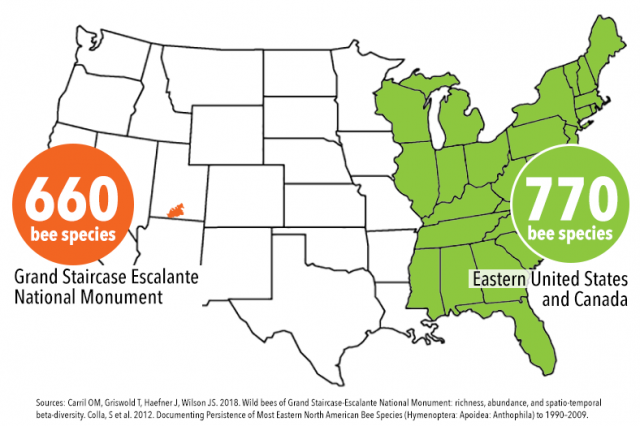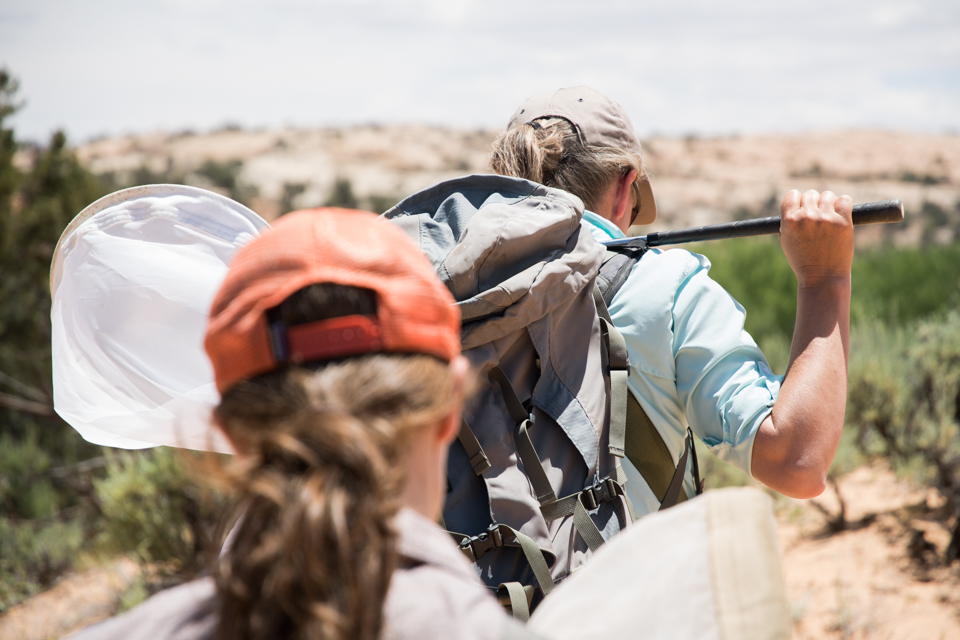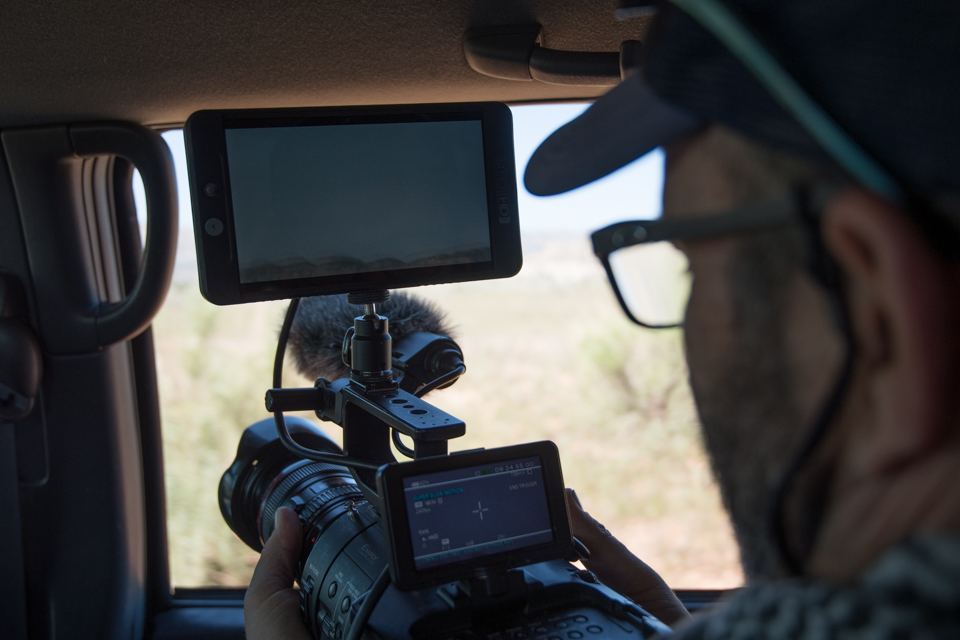Awesome Project: The Bees of Grand Staircase-Escalante
Published July 09, 2019
Matt Kelly is a freelance journalist based in the Finger Lakes of New York. The steppes of Grand Staircase-Escalante are pretty far from home–over 2,000 miles, to be exact. And yet, it’s completely natural that he’s there. But he’s also a citizen scientist–a passionate amateur ecologist.
That’s how his ioby project got started.
“I had reached out to a researcher named Joe Wilson because he had published some really interesting work,” Matt said. After going back and forth about a story that Matt was working on, Joe sent one more email. “He says, ‘Hey, take a look at this map,’ which shows the number of bee species on the east coast versus just in Grand Staircase-Escalante National Monument. And they’re roughly the same,” Matt said. 660 species in the Monument, 770 in the entire Eastern United States and Canada.
What the map showed was astonishing. An area not much larger than the state of Delaware, perched on the remote and arid southern edge of Utah, contained a mind bogglingly large number of bee species. It’s an ecological community that Joe and fellow biologist Olivia Carril had also done research on fifteen years prior, recording a snapshot of the bees at that moment in time. But there was still so much more to learn about this unique hotspot, and Matt wanted to tell its story.

“We don’t have many other places like this in North America. We don’t have wild, primitive places that act as refuges,” Matt said. “And the more we break them up, the greater disadvantage we are at in terms of understanding how humans are changing the world. The only reason we know that certain bee species are in decline is because we have a baseline. We have historical data. Without that comparison you can’t demonstrate change. Grand Staircase is essential because it’s a living lab for understanding the bee-flower relationships that are the basis of nearly every terrestrial ecosystem on the planet. And it allows us to compare the world as we’re changing it to the world as it would be if left primitive and wild.
Matt’s original idea was to return to the monument with Olivia, Joe and Tony DiZinno, his friend and Director of Photography, to survey the bees and compare their observations with the original study to get a better understanding of the bees’ health. Are there any differences? What might they mean? Is there serious trouble ahead for the bees and the monument’s ecology?
The results of their study would have implications on our understanding of bees and their widely reported decline, and could help environmentalists and officials better protect them in the future. Additionally, they planned to couple the study with a documentary film chronicling the story of the bees and their crucial ecological function, helping to shape a new appreciation among the viewing public for the 660 species that call the monument home.
That’s particularly significant given how crucial a role bees play in ecological systems the world over. “Bees are part of this intricate, beautiful, exquisite, absolutely necessary pollination network that is the underpinning of life all across the world. You can’t just talk about bees in isolation, you have to talk about them with the flowers that they’re directly connected to. And then, of course, that leads all the way up the ecological chain,” Matt said.
Then, the unimaginable happened. “When President Trump was elected and started talking about how he was going to reduce public lands, the Grand Staircase-Escalante National Monument in particular, our conversation took a 90 degree turn,” Matt said “The conversation was no longer just about what amazing bee biodiversity exists in a place like Grand Staircase, but it became about, ‘What will happen to the bees if the boundaries change? If there’s increased human activity? If there’s increased extractive industry that’s allowed there?” Two years into his presidency, the Trump administration followed through and dramatically shrunk the size of Grand Staircase-Escalante by 50 percent. Neighboring Bear Ears National was constricted even more dramatically, by a full 85 percent, opening the door to destructive mining and drilling in one of the nation’s most pristine landscapes.
It added urgency to the study, and lent a new weight to the film.

“Each one of these bee communities in the monument is unique in and of itself,” Matt said. The incredibly diverse landscape is home to noticeably different communities at the top of a mesa and at the bottom of an arroyo; even within a few hundred yards of each other, bee communities can vary.
“The conflict between this bee hotspot and the changing boundaries raised the question about why a big, contiguous place, like a single monument, is so important. And the reason is because big, contiguous pieces of land tend to provide better refuge for wildlife,” Matt said. “That’s why this project is equal parts documentary film and research. Because the fundraising that we did wasn’t just to make a film, it was also to get Joe and Olivia back on the ground to do research because funding does not exist for that.”
Studying changes in bee populations – or any insect population – requires time and patience. One thing Olivia and Joe’s work has found already is that many bee species can be readily abundant one year, nearly absent the next, and then abundant again in some following year. If you were to only compare two points in time, you’d likely have a false sense of how well certain bees are faring in our modern world. Studying the bees consistently and regularly over many years helps to build a more accurate picture of changes, and the stability of their communities. The fear, Matt says, is that the changes being made to Grand Staircase-Escalante are proceeding with little to no consideration for the unique bee communities living there, risking the loss of this vast treasure trove of information before we even have a chance to learn from it.
“Our aim with the film is really to raise awareness about this. And then the second piece is to promote action,” Matt said. The film itself is not intended to be focused only on the boundary changes. Talking about the bees of Grand Staircase means we have to talk about what the Trump administration has done. That’s just an inherent part of the story. But, the bigger story is how do we take bees into consideration as we make changes in this world, because bees are part of that network that is essential to all life.”

The film aims to be a part of that conversation. But in order to add to it, they’d need to raise the funds to bring it to life. So they turned to ioby to raise over $28,000, a sum much larger than most ioby projects, which average around $4,000. To achieve that feat, Matt would rely on his small but mighty team: Suzanne, his wife who is a clean energy consultant and had run her own ioby campaign before, Tony, the team’s Director of Photography, and Joe and Olivia, their resident biologists. Collectively, they were all able to tap into a diverse network of people to climb steadily towards their goal.
“Obviously it’s a matter of connections,” Matt said. “The more diverse the team you have, the more skill sets you can rely on. I’d never fundraised before, but my wife had. The connections are important because you can reach out to different people.”
Those networks grew outward, and led to more folks who were able to contribute. “People on my team know people who know people who know people. That’s the network I’m talking about. It’s not a cold call. It’s not this pitch coming out of nowhere. There’s a trusted line of communication saying, ‘Hey, you might want to think about this.’ And that’s super valuable.”
Having successfully crowdfunded, the team set out earlier this spring to conduct their study and film the documentary. They spent eight days in the field with the bees, and came back with a treasure trove of data and film. Now, they dig in to editing, hoping for a film debut in 2020.
“I think, ultimately, this is about understanding how connected humanity is to the world around us. I would say it’s understanding our place in the natural world,” Matt said. “ This whole idea that the Earth would be better without humans, I think that’s crap. I know humans have done a lot of bad in this world, but humans have also done a lot of good. Humans have done an immense amount of good when we’ve created national monuments and preserved wild places. We’re able to do that even in our own backyards.
“We’re able to take our lawns and convert them into local, urban refuges for bees, for example. Cities have great potential to provide the things that insects need to keep our world going. But that’s incumbent upon us to actually make it happen. You can’t just say, ‘Oh, cities are great.’ And let them do their thing. We have to be thoughtful and mindful and attentive to what we’re doing.”
The Bees of Grand Staircase-Escalante trailer from Matt Kelly on Vimeo.
Watch the trailer for the film above. You can stay up to date on the Bees of Grand Staircase-Escalante film and research at BEESofGSENM.com or by following Matt on Twitter (@bymattkelly).
Have an idea to strengthen your own community? We want to help! Let us know what your great idea is.
